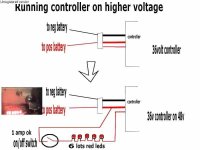Guys, I got myself an EVTech BMC motor. The motor is very well built with plenty of torque.
But running stock @ 36V there's just not enough at the high end. Top speed is less than 20 mph.
Is there something I can do to get into the 30mph range. I heard that the clyte controller 36-72V no longer works with these after the digital upgrade (what ever that means).
Is there another brushless controller out there that can take it up to the +50V range?
Thanks
But running stock @ 36V there's just not enough at the high end. Top speed is less than 20 mph.
Is there something I can do to get into the 30mph range. I heard that the clyte controller 36-72V no longer works with these after the digital upgrade (what ever that means).
Is there another brushless controller out there that can take it up to the +50V range?
Thanks


